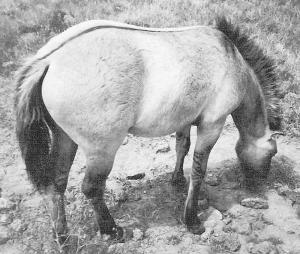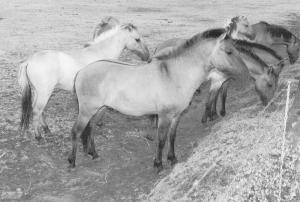2003 - Volume #27, Issue #1, Page #23
[ Sample Stories From This Issue | List of All Stories In This Issue | Print this story
| Read this issue]
Extinct Tarpen Recreated
 |
 |
It's believed by many that most modern horse breeds descended from the Tarpan, which were found in Russia and Europe thousands of years ago. Some of the earliest prehistoric cave drawings in Europe depict this wild ancestor of the modern horse.
Wild Tarpans could still be found in Eastern Europe during the early 1800's, but the last known one died in 1879. The last captive purebred Tarpan died in 1887 in Poland.
When the Polish government realized what had happened to the Tarpan breed, it began seizing farm horses that exhibited Tarpan traits. These were released into a game preserve called the Bialowieza Forest. The horses interbred and their offspring today are known as Tarpans.
Oregon rancher Harry Hegardt began a breeding program in the early 1960's to try to recreate the original Tarpan. He bred the Polish Tarpan to mustangs. When he died in 1990, Lenette and Gordin Stroebel bought what was left of the herd and are now continuing Hegardt's work.
"Over the years, Harry had used a number of mustang stallions to increase the gene pool and enhance the traits he wanted," Lenette says.
Tarpans were, for the most part, mouse gray in color, with sturdy dark colored hooves that don't need shoes. They were smaller than most modern horses, with a rounder, more muscular physique. Tarpans displayed a dominant dark dorsal stripe that extended from the mane to the tail. They also had finger-striping on their forelegs and cobwebbing on their foreheads. Most of the Stroebel Tarpans have those markings.
Another notable Tarpan characteristic is a stand-up mane. Many of the Stroebel Tarpans have it but not all. Lenette says she's confident that most will have erect manes before long.
The Stroebels maintain a herd of 30 to 40 Tarpans. Lenette says they are good saddle horses and, for the most part, are gentle and easily trained. They've sold several horses, mostly geldings for riding. "They're smooth and sure-footed, so are great for trail and pleasure riding," she says.
Concerned about the narrow gene pool in their Tarpans, the Stroebels continue to watch for wild mustangs with Tarpan-like traits. They are in the process of incorporating a breed registry which would use microchips and photographs to identify registered animals. They've already started implanting microchips in their horses. They'd like to talk to anyone with an interest in the Tarpan.
Contact: FARM SHOW Followup, Lenette and Gordon Stroebel, 4581 N. McKay Road, Prineville, Oregon 97754 (ph 541 447-4821; E-mail: tarpans@webtv.net).

Click here to download page story appeared in.

Click here to read entire issue
To read the rest of this story, download this issue below or click here to register with your account number.




